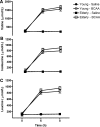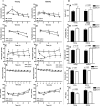The effect of branched chain amino acids on skeletal muscle mitochondrial function in young and elderly adults
- PMID: 20022987
- PMCID: PMC2840857
- DOI: 10.1210/jc.2009-1822
The effect of branched chain amino acids on skeletal muscle mitochondrial function in young and elderly adults
Abstract
Context: A reduction in maximal mitochondrial ATP production rate (MAPR) and mitochondrial DNA (mtDNA) abundance occurs with age in association with muscle weakness and reduced endurance in elderly people. Branched chain amino acids (BCAA) have been extensively used to improve physical performance.
Objective: The objective was to determine whether an 8-h infusion of BCAA enhances MAPR equally in healthy young and elderly adults.
Methods: Using a crossover study design, we compared the effect BCAA vs. saline infusion in 12 young (23.0 +/- 0.8 yr) and 12 elderly (70.7 +/- 1.1 yr) participants matched for sex and body mass index. Skeletal muscle MAPR and mtDNA abundance were measured in muscle biopsy samples obtained before and at the end of the 8-h infusion.
Results: In young participants, MAPR with the substrates glutamate plus malate (supplying electrons to complex I) and succinate plus rotenone (complex II) increased in response to BCAA infusion, relative to a decline in MAPR in response to the saline infusion. In contrast, MAPR was unaffected by BCAA infusion in the elderly participants. Moreover, mtDNA abundance was lower in the elderly compared with the young participants but was unaffected by the BCAA infusion. Insulin and C-peptide concentrations declined over time during the saline infusion, but these declines were prevented by the BCAA infusion.
Conclusions: BCAA increased skeletal muscle MAPR in the young participants in comparison with saline, but this effect was not seen in the elderly participants indicating, that unlike in the young, BCAA does not increase muscle mitochondrial function in the elderly.
Figures





Similar articles
-
Diabetes and branched-chain amino acids: What is the link?J Diabetes. 2018 May;10(5):350-352. doi: 10.1111/1753-0407.12645. Epub 2018 Feb 13. J Diabetes. 2018. PMID: 29369529
-
Effect of insulin deprivation on muscle mitochondrial ATP production and gene transcript levels in type 1 diabetic subjects.Diabetes. 2007 Nov;56(11):2683-9. doi: 10.2337/db07-0378. Epub 2007 Jul 27. Diabetes. 2007. PMID: 17660267
-
Adenosine Triphosphate Production of Muscle Mitochondria after Acute Exercise in Lean and Obese Humans.Med Sci Sports Exerc. 2019 Mar;51(3):445-453. doi: 10.1249/MSS.0000000000001812. Med Sci Sports Exerc. 2019. PMID: 30363008 Free PMC article.
-
Dietary supplementation of branched-chain amino acids increases muscle net amino acid fluxes through elevating their substrate availability and intramuscular catabolism in young pigs.Br J Nutr. 2017 Apr;117(7):911-922. doi: 10.1017/S0007114517000757. Epub 2017 Apr 27. Br J Nutr. 2017. PMID: 28446262 Clinical Trial.
-
Insulinotropic and muscle protein synthetic effects of branched-chain amino acids: potential therapy for type 2 diabetes and sarcopenia.Nutrients. 2012 Nov 8;4(11):1664-78. doi: 10.3390/nu4111664. Nutrients. 2012. PMID: 23201839 Free PMC article. Review.
Cited by
-
Effects of acute exposure to increased plasma branched-chain amino acid concentrations on insulin-mediated plasma glucose turnover in healthy young subjects.PLoS One. 2015 Mar 17;10(3):e0120049. doi: 10.1371/journal.pone.0120049. eCollection 2015. PLoS One. 2015. PMID: 25781654 Free PMC article. Clinical Trial.
-
Probiotic Supplementation Facilitates Recovery of 6-OHDA-Induced Motor Deficit via Improving Mitochondrial Function and Energy Metabolism.Front Aging Neurosci. 2021 May 7;13:668775. doi: 10.3389/fnagi.2021.668775. eCollection 2021. Front Aging Neurosci. 2021. PMID: 34025392 Free PMC article.
-
Performance Enhancing Diets and the PRISE Protocol to Optimize Athletic Performance.J Nutr Metab. 2015;2015:715859. doi: 10.1155/2015/715859. Epub 2015 Apr 20. J Nutr Metab. 2015. PMID: 25949823 Free PMC article. Review.
-
Mitochondrial respiratory capacity and coupling control decline with age in human skeletal muscle.Am J Physiol Endocrinol Metab. 2015 Aug 1;309(3):E224-32. doi: 10.1152/ajpendo.00125.2015. Epub 2015 Jun 2. Am J Physiol Endocrinol Metab. 2015. PMID: 26037248 Free PMC article.
-
Post-Game High Protein Intake May Improve Recovery of Football-Specific Performance during a Congested Game Fixture: Results from the PRO-FOOTBALL Study.Nutrients. 2018 Apr 16;10(4):494. doi: 10.3390/nu10040494. Nutrients. 2018. PMID: 29659539 Free PMC article. Clinical Trial.
References
-
- Dutta C, Hadley EC 1995 The significance of sarcopenia in old age. J Gerontol A Biol Sci Med Sci 50A:1–4 - PubMed
-
- Melton 3rd LJ, Khosla S, Crowson CS, O'Connor MK, O'Fallon WM, Riggs BL 2000 Epidemiology of sarcopenia. J Am Geriatr Soc 48:625–630 - PubMed
-
- Short KR, Vittone JL, Bigelow ML, Proctor DN, Rizza RA, Coenen-Schimke JM, Nair KS 2003 Impact of aerobic exercise training on age-related changes in insulin sensitivity and muscle oxidative capacity. Diabetes 52:1888–1896 - PubMed
Publication types
MeSH terms
Substances
Grants and funding
LinkOut - more resources
Full Text Sources
Other Literature Sources

